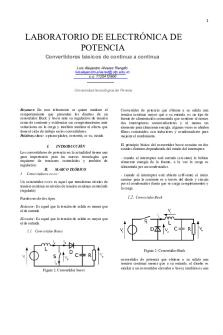C-C formation - Reacciones para formar enlaces carbono-carbono PDF

| Title | C-C formation - Reacciones para formar enlaces carbono-carbono |
|---|---|
| Author | Andrea |
| Course | Bioquímica |
| Institution | Universidad de Puerto Rico |
| Pages | 3 |
| File Size | 204 KB |
| File Type | |
| Total Downloads | 33 |
| Total Views | 245 |
Summary
Reacciones para formar enlaces carbono-carbono...
Description
Andrea P. Oliveras 8/24/2020 801-18-5143 Dr. Kai H. Griebenow Reactions leading to C-C bond formation 1. Grignard
A Grignard reaction can’t be found in nature that is because its reagents must react without the presence of water or moisture. This is because water or alcohols would protonate and decompose the Grignard reagent, thanks to the Grignard carbon being highly nucleophilic. 2. Gilman
The Gilman reaction like the Grignard reaction uses an organometal to add a carbon chain and must be synthesized in a controlled environment therefore it does not occur naturally in the environment. 3. Stille Coupling
This reaction is a palladium-catalyzed reaction between stannanes and halides or pseudohalides elaborated synthetically. It is not something that occurs naturally in the environment and furthermore reaction results in toxic waste from the tin compounds used. Their low polarity also makes them poorly soluble in water, further damaging the environment.
4. Heck
Catalyzed by palladium this reaction involves the coupling of aryl or vinyl halides in the presence of a base and it’s reaction used during synthesis in organic chemistry. This reaction needs high temperatures, an inert atmosphere and long reaction time therefore it is not something found in nature. 5. Suzuki
This is a type of coupling between an organoboronic acid and halides used in organic chemistry involving a palladium catalyst. Yet another reaction that needs to be done under specific conditions for it to be occur. 6. Metathesis
The Metathesis reaction is most likely to occur only by synthetization in a laboratory because it would need a metal catalyst.
7. Aldol Condensation
Aldol reactions are likely to occur in nature, but in contrast to organic chemistry which uses this reaction in synthesis to form C-C bonds, in biochemistry a reverse(retro) aldol reaction is most likely to happen. Some examples of this are the splitting of fructose-1,6-bisphosphate into dihydroxyacetone and glyceraldehyde-3-phosphate in the fourth stage of glycolysis (reactions catalyzed by the enzyme aldolase). This process is also present in the glyoxylate cycle of plantas and some prokaryotes. Bibliography 1. “Aldol Reactions in Metabolism (Article).” Khan Academy. Khan Academy. Accessed August 22, 2020. https://www.khanacademy.org/test-prep/mcat/chemical-processes/alpha-carbonchemistry/a/aldol-reactions-in-metabolism. 2. “Grignard ReactionGrignard Reagents.” Organic Chemistry. Accessed August 22, 2020. https://www.organic-chemistry.org/namedreactions/grignard-reaction.shtm. 3. “Heck Reaction.” Organic Chemistry. Accessed August 22, 2020. https://www.organicchemistry.org/namedreactions/heck-reaction.shtm. 4. Illustrated Glossary of Organic Chemistry - Aldol Condensation; Crossed Aldol Condensation; Claisen-Schmidt Condensation. Accessed August 22, 2020. http://www.chem.ucla.edu/~harding/IGOC/A/aldol_condensation.html. 5. “Olefin Metathesis Catalyst.” Olefin Metathesis Catalyst | TCI Deutschland GmbH. Accessed August 22, 2020. https://www.tcichemicals.com/AT/de/supportdownload/tcimail/application/104-17. 6. says:, Dion, Janna says: James says: Charles says: Stephanie says: Ab Says: Olivia says: et al. “Gilman Reagents (Organocuprates): What They're Used For.” Master Organic Chemistry, May 26, 2020. https://www.masterorganicchemistry.com/2016/02/05/gilman-reagentsorganocuprates-what-theyre-used-for/. 7. “Stille Coupling.” Organic Chemistry. Accessed August 22, 2020. https://www.organicchemistry.org/namedreactions/stille-coupling.shtm. 8. “Suzuki Coupling.” Organic Chemistry. Accessed August 22, 2020. https://www.organicchemistry.org/namedreactions/suzuki-coupling.shtm....
Similar Free PDFs

Enlaces
- 7 Pages

Practica Enlaces
- 34 Pages

Convertidor CC-CC
- 12 Pages

Practica 5 - enlaces quimicos
- 7 Pages

Guia 3 Enlaces quimicos
- 12 Pages

Tarjeta madre y enlaces
- 16 Pages

Enlaces a vídeos
- 4 Pages
Popular Institutions
- Tinajero National High School - Annex
- Politeknik Caltex Riau
- Yokohama City University
- SGT University
- University of Al-Qadisiyah
- Divine Word College of Vigan
- Techniek College Rotterdam
- Universidade de Santiago
- Universiti Teknologi MARA Cawangan Johor Kampus Pasir Gudang
- Poltekkes Kemenkes Yogyakarta
- Baguio City National High School
- Colegio san marcos
- preparatoria uno
- Centro de Bachillerato Tecnológico Industrial y de Servicios No. 107
- Dalian Maritime University
- Quang Trung Secondary School
- Colegio Tecnológico en Informática
- Corporación Regional de Educación Superior
- Grupo CEDVA
- Dar Al Uloom University
- Centro de Estudios Preuniversitarios de la Universidad Nacional de Ingeniería
- 上智大学
- Aakash International School, Nuna Majara
- San Felipe Neri Catholic School
- Kang Chiao International School - New Taipei City
- Misamis Occidental National High School
- Institución Educativa Escuela Normal Juan Ladrilleros
- Kolehiyo ng Pantukan
- Batanes State College
- Instituto Continental
- Sekolah Menengah Kejuruan Kesehatan Kaltara (Tarakan)
- Colegio de La Inmaculada Concepcion - Cebu








